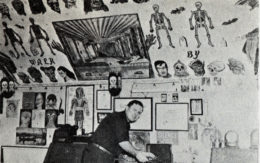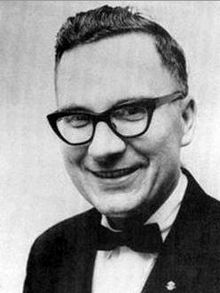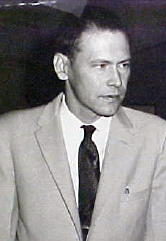by Charles Lear
 In the early years of the flying saucer mystery, the U.S. Air Force was the only organization doing any sort of significant investigation. Then, in 1952, a number of private groups were organized and the first citizen investigators went into the field and endeavored to solve the mystery for themselves. The first of these to rise to global attention was the International Flying Saucer Bureau, founded by Albert K. Bender. They put out a quarterly publication called Space Review, and were taken seriously by their fellow enthusiasts. They didn’t last long, however, as Bender put an end to his creation in 1953 after telling his followers he had solved the mystery. He later informed them he’d been visited by three men wearing black suits and homburg hats, who’d threatened him into keeping silent about his discovery. The mythos of the Men in Black entered flying saucer lore and the Bender Mystery became a subject that is still being debated today.
In the early years of the flying saucer mystery, the U.S. Air Force was the only organization doing any sort of significant investigation. Then, in 1952, a number of private groups were organized and the first citizen investigators went into the field and endeavored to solve the mystery for themselves. The first of these to rise to global attention was the International Flying Saucer Bureau, founded by Albert K. Bender. They put out a quarterly publication called Space Review, and were taken seriously by their fellow enthusiasts. They didn’t last long, however, as Bender put an end to his creation in 1953 after telling his followers he had solved the mystery. He later informed them he’d been visited by three men wearing black suits and homburg hats, who’d threatened him into keeping silent about his discovery. The mythos of the Men in Black entered flying saucer lore and the Bender Mystery became a subject that is still being debated today.
 Albert K. Bender was born on July 16, 1921 in Duryea, Pennsylvania. What the “K” stood for seems to be part of the mystery. He served stateside as a dental technician in the U.S. Army Air Forces from June 8, 1942 to Oct. 7, 1943. He was stationed at Langley Field, Virginia. After his service, he moved to Bridgeport, Connecticut with his mother and stepfather. His mother died shortly thereafter.
Albert K. Bender was born on July 16, 1921 in Duryea, Pennsylvania. What the “K” stood for seems to be part of the mystery. He served stateside as a dental technician in the U.S. Army Air Forces from June 8, 1942 to Oct. 7, 1943. He was stationed at Langley Field, Virginia. After his service, he moved to Bridgeport, Connecticut with his mother and stepfather. His mother died shortly thereafter.
Bender lived in the attic, which had a bedroom and a den. He was employed as the chief timekeeper at the Acme Shear Company. It may have been a conscious nod to his profession or just an ironic coincidence, but Bender had twenty clocks in his living space that all would ring, chime and clang every fifteen minutes.
The clocks were just one of the many manifestations of Bender’s eccentric nature that increasingly expressed itself as he entered his late twenties. He was a fan of horror movies, ghost stories and the occult. He adorned his attic space with Halloween decorations, fake skulls, shrunken heads, rubber spiders and snakes, and his own macabre paintings. When friends came over, he put on recordings of spooky noises and enjoyed showing off what he called his “Chamber of Horrors.” His offbeat interests and living space were interesting enough that an article was written about him and published in the May 25, 1952 Sunday Herald, a local Bridgeport newspaper.
Flying saucers were added to Bender’s list of interests and they eventually became his chief interest. Bender and some friends formed the IFSB in April 1952 and its membership quickly grew beyond the borders of Connecticut. The first Space Review, put out in Oct. 1952, included a list of representatives in 14 states and one in Ontario, Canada. Bender had a letter announcing the formation of the group published in the Dec. 1952 issue of the Ray Palmer publication, Other Worlds. The letter captured the attention of Flatwoods Monster investigator, Gray Barker, who contacted Bender and expressed his desire to become a member. Bender convinced him to become the state representative for West Virginia.
 Barker would later become the chief investigator for the organization and he became good friends with many in the group. By this time, the group had lived up to its name and was truly international. There were chapters in South America, Europe, and the IFSB was in contact with newly formed organizations in Australia and New Zealand. They inspired people all around the world to form their own groups and citizen investigators were here to stay. The IFSB, however, was not. Barker wrote about the events leading to its demise in his 1956 book, “They Knew Too Much About Flying Saucers.”
Barker would later become the chief investigator for the organization and he became good friends with many in the group. By this time, the group had lived up to its name and was truly international. There were chapters in South America, Europe, and the IFSB was in contact with newly formed organizations in Australia and New Zealand. They inspired people all around the world to form their own groups and citizen investigators were here to stay. The IFSB, however, was not. Barker wrote about the events leading to its demise in his 1956 book, “They Knew Too Much About Flying Saucers.”
According to Barker in his book, he received a letter from Bender dated Sept. 16, 1953. It contained the mysterious instruction not to accept any more memberships until he’d seen the Oct. issue of Space Review. He then received a letter on tape from New Jersey based member, Domonic Lucchesi. This was common among members as, according to Barker, a saucer investigator without a tape recorder “is considered almost a non-entity.”
Lucchesi described being present when fellow member August C. Roberts called Bender to cancel their planned visit because of car troubles. In the course of the conversation it came out that Bender was unsure whether there would be another issue of Space Review after October. Bender then said he’d discovered the secret of the flying disks and told Roberts about the visit by the three men. He said they confiscated his copies of back issues of the magazine and, as an American citizen, he was sworn to secrecy about his discovery.
In the Oct. 1953 Space Review, Bender announced, “The mystery of flying saucers is no longer a mystery.” He apologized for not being able to elaborate saying, “because of the nature of the information we have been advised in the negative.”
Barker got in touch with Roberts and suggested Roberts and Lucchesi go to Connecticut and speak to Bender in person. Barker emphasized it was important they remember everything that was said. They were sure Bender wouldn’t allow a tape recorder or a note pad and Barker suggested Roberts should slip away to the bathroom periodically where he could make notes unseen. He could tell Bender he’d taken a laxative or had bowel issues. Roberts complained he wasn’t a good actor and Barker suggested he should actually take a laxative.
Roberts and Lucchesi interviewed Bender and, while they didn’t get the answer to the mystery, they did get some interesting replies to some of their questions. He told them the government had known what the saucers were for two years and if they didn’t tell the public in the next five months, it would be four years before they did so.
After the Oct. 1953 issue, only three more issues of Space Review were published. These were for the members that didn’t want refunds. Flying saucers were not even mentioned and the articles focused solely on space. The IFSB was closed.
Barker was putting out his own magazine, The Saucerian, and he reached out to his readers to help him solve the Bender Mystery. Some of them speculated but no one came up with a convincing explanation.
The Aerial Phenomena Research Organization had formed in the fall of 1951 just prior to IFSB. APRO’s director, Coral Lorenzen, offered the suggestion in the Nov. 15, 1953 APRO Bulletin that a pulp magazine publisher (Ray Palmer?) had been funding IFSB and had backed out. Lorenzen reasoned that with no funds to run the organization, Bender had made up the story in order to be done with it. Barker assures the reader in his book that this was not the case.
David Houchin, curator of the Gray Barker collection at the Clarksburg-Harrison Public Library in West Virginia, came up with a theory during a Gray Barker tribute on the radio show “Exploring the Bizarre.” Houchin presents a scenario based on two letters to Bender that are housed in the collection. According to him, a man in Clarksburg suffered an epileptic seizure and was taken to the hospital. Someone had taken his wallet but he had Barker’s IFSB business card on him. An official visited Barker and interviewed him in an attempt to identify the man. Barker claims in his book that the official showed him FBI credentials while Houchin feels he was probably a local police detective. Barker got paranoid, called Bender and got no answer because Bender was on vacation. He then wrote to Bender that he’d been investigated by the FBI and others should expect the same. Barker also called Washington, DC based member Rev. S. L. Daw, and gave him the same information. Daw had been seeing flying saucers everywhere, was taking pictures and some of them were taken at a restricted site. The day after Barker called him, three actual FBI agents visited him and he wrote a letter to Bender to tell him about it.
Bender came back from his vacation to find Barker’s and Daw’s letter waiting for him. Houchin suggests this panicked Bender and he adopted Daw’s three-man scenario as an excuse to shut down the organization.
Barker played up the paranoia in his book and the MiB mythos took root. Bender wrote his own book, “Flying Saucers and the Three Men”, which was published by Barker through his Saucerian Books in 1962. In Bender’s book, the three men become three ethereal creatures with glowing eyes from the planet Kazik, pronounced with a long “a” and a silent “z.” Could Kazik have been what the mysterious “K” stood for in Bender’s name? Bender’s book was met with dubiousness by most in the flying saucer community.
There are now three major speculations making the rounds in UFOlogical and paranormal discussions on radio, the web and in literature. One is that Bender came up with a story to get out of the flying saucer business, one is that he was visited by MiB of either governmental or extraterrestrial origin and the third is that his interest in the occult caused him to call up some entities he couldn’t get rid of. Where one comes down on the Bender Mystery is a good indication of one’s place in the world of the paranormal.